Top 10 Cheapest Electric Cars You Should Buy in 2022/2023
 |
| Top 10 Cheapest Electric Cars You Can Buy in 2022/ 2023 |
| Table of Content |
Electric cars have become a byword for expensive vehicles. There's some merit to that. Battery technology isn't cheap. Electric cars — not building on a century of combustion engine development — require more research and development. An electric car will likely be significantly more expensive than its combustion counterpart. But that's not the whole story.
Electric cars tend to be more expensive than their petrol or diesel-powered counterparts, but prices are coming down, and a new generation of circa-£20,000 EVs will be arriving within the next few years, capable of easily covering over 200 miles on a charge. Plus, electric cars generally are far less expensive to run and attract lower company-car tax, so you claw back the difference over the course of ownership.
The higher prices of electric cars mean that you get less for your money – you might only be able to afford a supermini with a budget that would normally get you into a larger family car, for example. If you want to get some of the benefits of an electric car without dropping into a smaller car, consider a hybrid or plug-in hybrid car.
Hybrids usually bring lower running costs than petrol or diesel equivalents, and plug-in models can still use electric power for 20 to 40 miles in most models. Even if you can’t charge up at home, a normal hybrid will be more efficient than a plain petrol car.
Here are the 10 cheapest electric cars that you can buy and have in 2022/2023.
Why are Electric Cars Becoming more Popular?
Performance and Range Improvements
The first electric cars to be released were slow, underpowered and lacked the battery capacity for longer trips. Alongside the premium price tag, these problems resulted in many customers losing interest and buying petrol or diesel vehicles instead.
Since the release of the first electric vehicles, vehicle makers from all around the world have refined their manufacturing processes and improved on existing technology. The results of these refinements are electric vehicles that can travel hundreds of miles off one charge. The performance of these vehicles has significantly improved, with vehicles such as Tesla’s Model S being able to overtake traditional sports cars.
Government Support
Throughout 2017, several countries have expressed an interest in phasing out the use of gasoline vehicles. The UK and France both plan to have all-electric roads by 2040. China has recently stated that it wishes to follow but has not specified a year. The removal of gasoline-powered vehicles in China will have a massive impact on the rest of the world, significantly increasing the demand for alternatively-powered vehicles.
Governments have begun pressuring car manufacturers, stating that a certain percentage of their sales will need to be for electric cars. This has resulted in many new electric and hybrid vehicles entering the market. Several vehicle manufacturers such as Volkswagen and Mercedes have pledged to offer electric variants of all their vehicles by the early 2020s.
Advancements in Technology
American company Tesla has changed a lot of people’s opinions on electric cars. Their vehicles feature advanced touch-screen interfaces, self-driving capabilities and much more. In the near future, we can expect to see completely autonomous vehicles on our roads. Following Tesla’s success, many automakers are producing electric vehicles with futuristic capabilities. The new Nissan Leaf features automatic braking, lane changing and more.
Lower Costs
Electric vehicles are becoming cheaper, making them more accessible to the general public. As well as being incredibly cheap to run, electric vehicles are becoming more widely produced, resulting in a drop in price. Due to electric vehicles being available for a while, buying a second-hand electric vehicle is also becoming much cheaper.
What to watch out for when buying a cheap electric car
Range: Lower-range EVs are workable in theory. Most drivers — even in the suburbs — don't drive 100 miles daily. But you typically only charge an EV to 80-90% except in rare circumstances. Cold weather can sharply reduce the range.
Tax Credits: Some (but not all) EVs are eligible for a $7,500 federal tax credit. That tax credit is non-refundable. So, you must owe $7,500 on your taxes to get back the total credit. On the other side, some states offer additional tax credits on top of the federal incentives that can make the price even cheaper.
What State You Live In: Not all EVs are sold in every state. Manufacturers may prioritize California and states that follow the California Air Resources Board (CARB) that require manufacturers to sell them over other states.
What are the cheapest electric cars that you can buy in 2022/2023?
1. Smart EQ ForTwo – $23,900
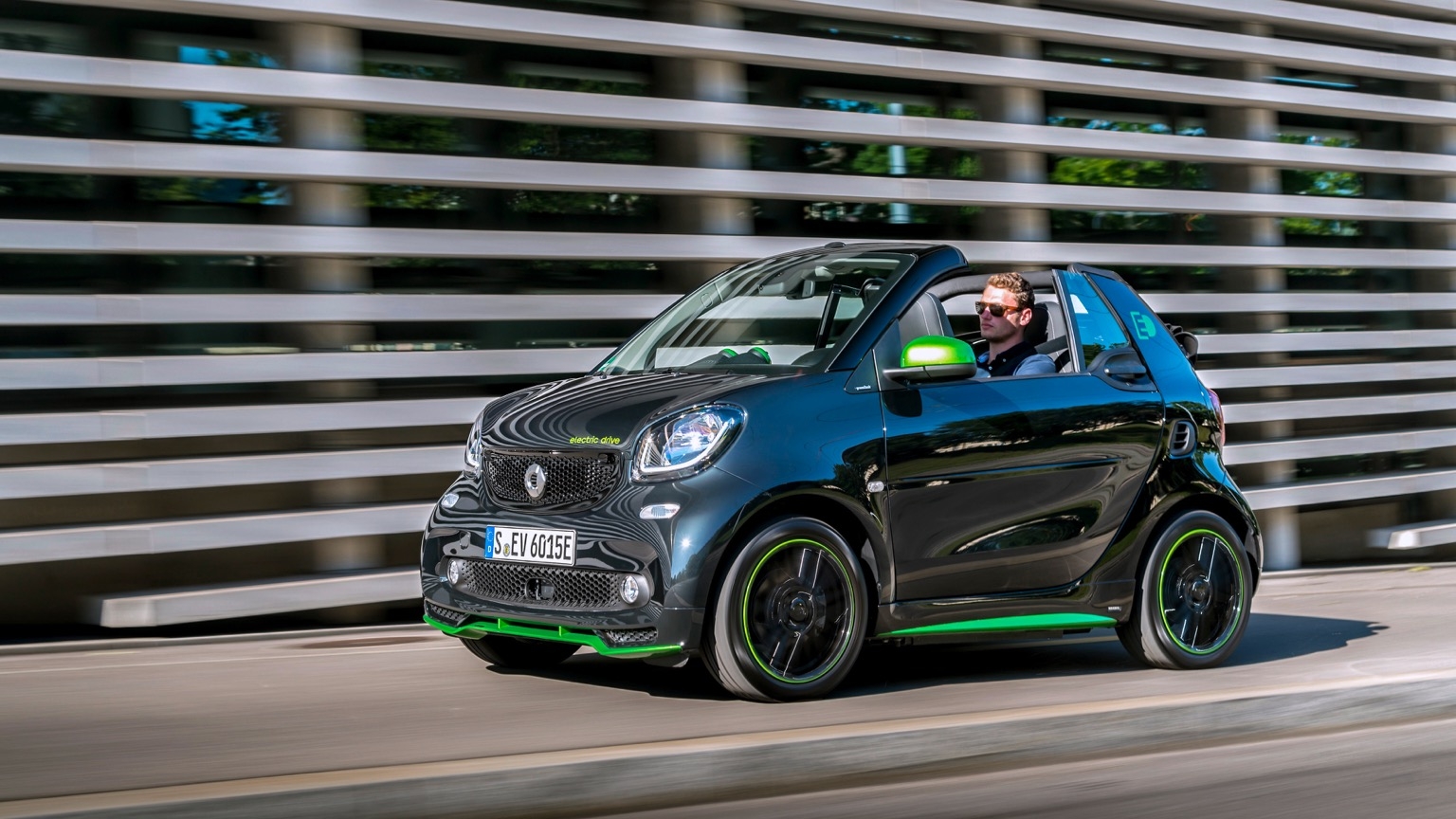 |
| Photo: EV Database |
The EQ ForTwo has a range of up to 81 miles, which is one of the lowest range estimates of any new electric car. But it’s a city car first and foremost, and people who rarely stray out of city limits won’t need much more than this. It feels a little out of its depth on motorways and dual-carriageways but, as an urban companion, it’s perfect – assuming you’ve got somewhere to park it and charge it up. In town it feels far nippier than its 11.6-second 0-62mph-time suggests, with instant zip allowing it to dash into gaps and away from lights. It takes around three-and-a-quarter hours to charge using a 7kW wallbox, which is the upside of its small battery - many electric cars need a whole night to recharge.
The EQ ForTwo competes with other small battery-powered cars like the Volkswagen e-up!, Fiat 500 and supermini-sized Renault Zoe. The update to the VW Group's trio of electric city cars has boosted their range to double that of the Smart, making them stiff competition - especially given how close in price they are to the Smart. Similarly, the fact the EQ ForTwo can only seat two definitely counts against it, but there's no denying its charm as a second car solely for use around town.
The EQ ForTwo is quite expensive for a city car, with prices starting from around £20,000 after the plug-in car grant. Once you’ve got it home, running costs are very low indeed. Road tax is free for electric cars with zero emissions, while the EQ ForTwo qualifies for the lowest Benefit-in-Kind rating, making it particularly attractive for business buyers. It’s exempt from the London Congestion Charge, along with other low-emissions zones cropping up in cities across the UK and Europe.
You’ll have to pay for the electricity its batteries use, but expect a full recharge to set you back a few pounds, which isn’t bad for up to 83 miles worth of travel for two people. Just remember that you’ll need to recharge more often in colder weather, like pretty much every electric car. A home wallbox will be the cheapest way to recharge, but you can also top up at public chargers when you’re out and about.
The biggest issue is practicality, not to do with size or range: as a town car, the EQ ForTwo works best if you’re able to charge it up at home. That’s not a problem if you’ve a driveway or an allocated parking space in your block of flats (complete with a power socket), but more problematic if you park on the street, as trailing a cable across the pavement is a bad idea. Some councils have started installing EV chargers in lamp posts and bollards.
Topping up the Smart's battery pack from 10 to 80% can take as little as 40 minutes using a 22kW fast-charger, extending to just over three hours if you use a conventional 7kW wallbox. Plug the EQ ForTwo into a domestic socket and the same charge will take up to six hours.
2. Smart EQ ForFour – $27,293
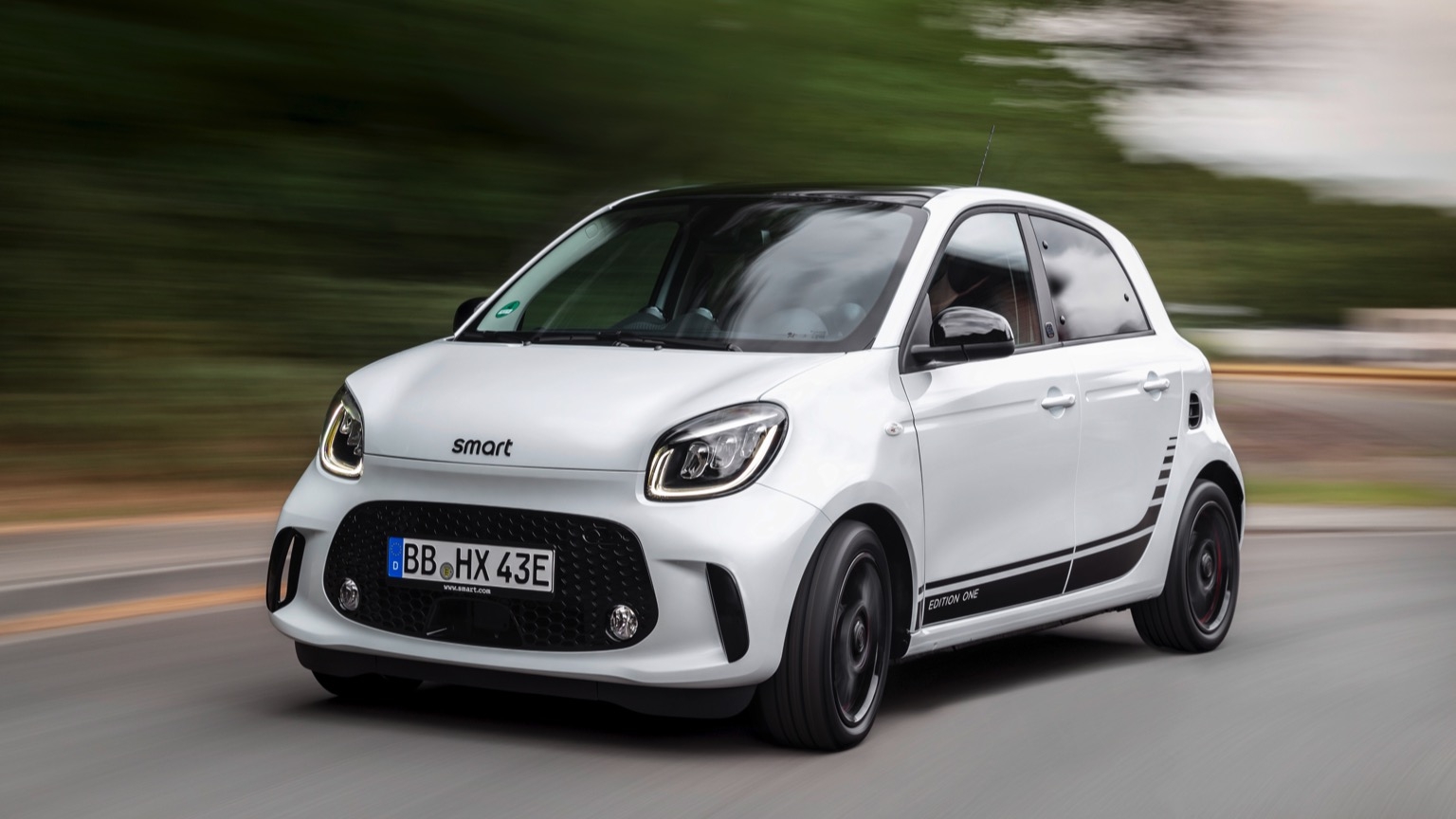 |
| Photo: EV Database |
Things that make a lot of sense: drinking coffee in the morning, avoiding reality TV shows at all costs and building city cars that run purely on electricity. OK, so the first two are detabale, but the third certainly isn’t.
EVs help improve local air quality, they’re zippy to drive from a standstill and silent with it, all of which can be said of the pure-electric Smart EQ forfour. However, it applies to its alternatives, too, such as the Skoda Citigo-e iV, VW e-Up and Renault Zoe.
The Smart’s look has changed a bit over the years but its same basic cheeky face remains despite a new grille and bumper. There are now more alloy wheel and colour choices than ever, too, allowing even more personalisation.
Inside the Smart EQ forfour’s dashboard has a funky design that changes slightly depending on which model you buy. Most of the plastics higher up are of decent quality, but some of those lower down and the Smart’s switches feel cheap.
Smart’s touchscreen infotainment system is poor too. Its sat-nav truly is one of the worst on sale and the screen is laggy to use. Happily, Apple CarPlay and Android Auto come as standard so you can mirror your smartphone instead.
Every forfour is powered by a 17kWh battery, which via a motor offers 81hp, a 0-62mph sprint of 12.7 seconds and a modest 70-mile range. Charging to 80% via a 22kWh fast charger takes less than 40 minutes, but a full charge at home using a 7kWh wall box will take more like four.
That home charge will cost you less than £3, which is around £7 cheaper than fueling the average petrol car over the same distance.
Although the forfour’s sprint to 62mph is pedestrian, it gets to around 40mph in less than five seconds, so feels urgent away from lights. It feels very manoeuvrable in town, too, but you’ll feel more lumps and bumps in the road than in an Up or Citigo.
Motorway journeys aren’t the most comfortable, either, and its light steering and bumpy drive remove much of the fun when cornering hard.
As such, it’s best to keep the Smart EQ forfour in an urban environment where it excels – bumpiness aside. It’s worth investigating the similarly priced and more spacious EV Citgo-e and e-Up first, but if you love the looks and don’t need the space then it’s worth a look.
3. 2022 Nissan Leaf - $27,000
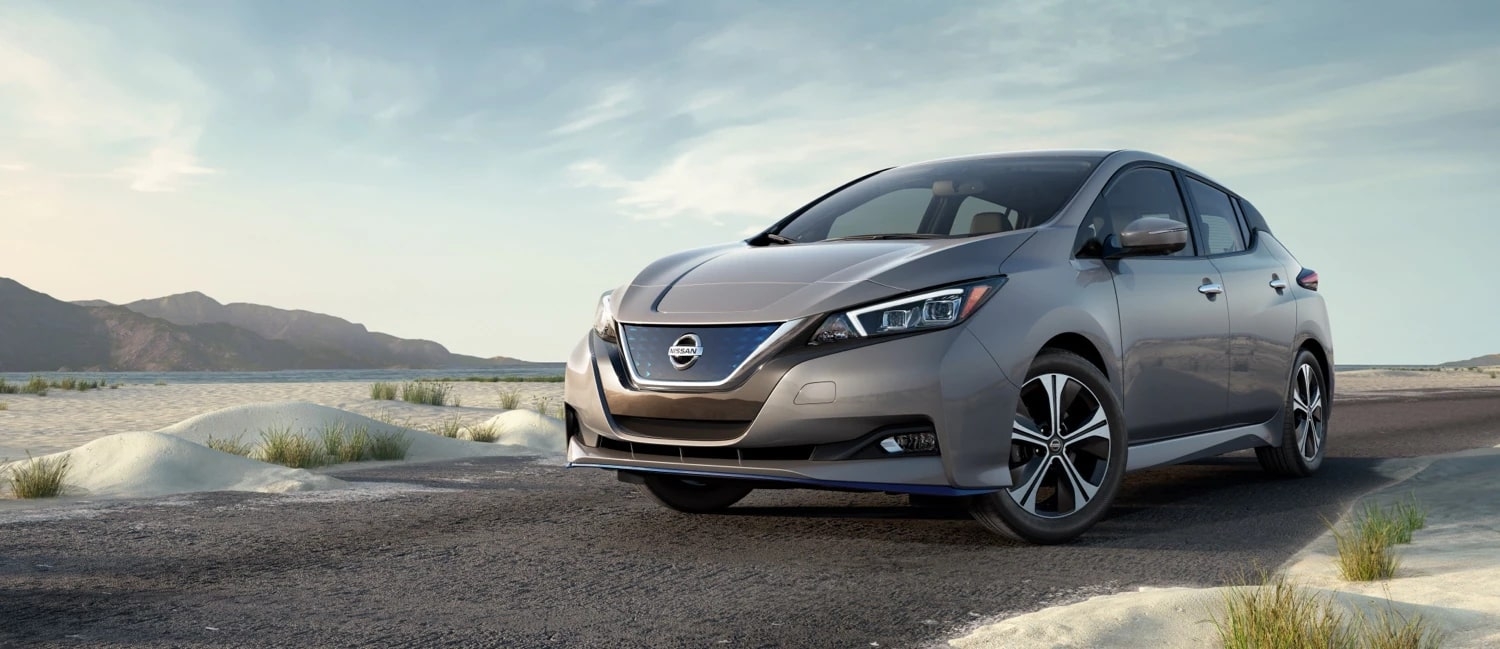 |
| Photo: Nissan USA |
The 2023 Nissan Leaf EV illustrates the difference between being attractive on paper and competitive in the real world. A starting price below $30,000 for any EV—this before any applicable tax credits—gets our attention. But, when compared to its rivals the Leaf’s driving range isn't as good and its outdated charging technology makes it less user-friendly. The Leaf’s longest-range battery pack enables barely more than 200 miles of driving range; the Chevy Bolt EV, and the considerably more expensive Kia EV6 and Tesla Model 3 all beat that by a considerable margin. What’s more, not all public charging stations are compatible with the Nissan's CHAdeMO charging connector. But if you're someone who plans to drive only around town and can set up for charging at home, the Leaf might work—and it provides a low-cost point of entry into the world of EVs. It’s a small hatchback, which means it’s easy to thread through congested city traffic and find street parking for. Its cabin is spacious for a small car, comfortable, and nicely equipped with tech features. Unfortunately, the same can be said of several competitors, many of which offer more every-day usability, longer range, and access to more charging stations.
Pricing and Which One to Buy
The best deal here is the SV Plus because it carries a reasonable price, the longest driving range, the more powerful electric motor, and offers a decent package of standard equipment. It has an 8.0-inch infotainment system with Apple CarPlay and Android Auto capability, automatic climate control, keyless entry with push-button start, and automatic headlamps.
EV Motor, Power, and Performance
Leafs are front-wheel drive cars. The standard Leaf S comes with a 147-horsepower electric motor and a 40.0-kWh battery pack—both dinky by today’s standards. Leaf SV Plus gets a gutsier, 214-hp electric motor and a larger 62.0-kWh battery. An S managed a 7.4-second zero-to-60-mph time at our test track, but it feels perkier than this number suggests thanks to the instantaneous power delivery of the electric motor. This result makes it slower than the Bolt EV and the Model 3, though. Upgrading to the more powerful Plus model will no doubt result in quicker acceleration, but we won't be able to confirm that until we are able to test one. The Leaf's e-Pedal feature allows the driver to toggle back and forth between regenerative braking modes, one of which allows the car to coast when the driver lifts off the throttle and another that slows the car when you take your foot off the gas and uses that energy to recharge the battery.
Range, Charging, and Battery Life
The Leaf can be plugged in to a regular 120-volt outlet or a 240-volt outlet, but the charging times vary dramatically between the two. On a 240-volt connection, Nissan says both the standard Leaf's battery and the larger one in the Leaf Plus can be replenished in seven hours. A DC fast-charging connection is standard on all trims. The Leaf S comes with a 40.0-kWh battery that provides a relatively limited range of 149 miles. This might be enough range for some drivers with short commutes but it's less than half of what the Model 3's Long Range model provides. The SV Plus provides 215 miles of EPA-rated driving range thanks to its larger battery pack.
4. Fiat 500 – $29,178
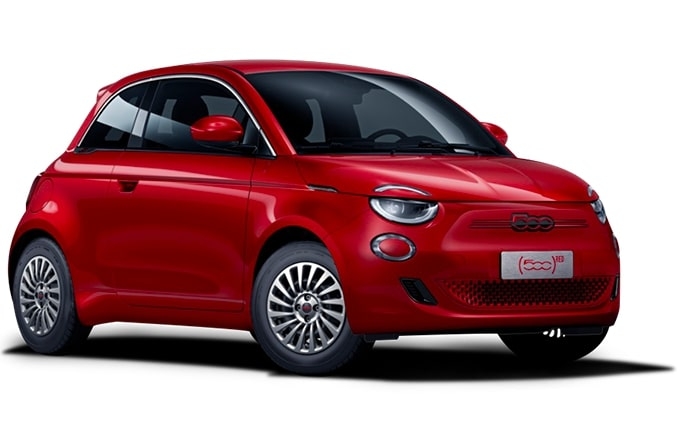 |
| Photo: Fiat |
It looks like a Fiat 500 all right. But you won’t find any component in this car that is in the existing one. The new 500 is bigger and uses a new interior, chassis, body and platform. Most obvious and significant, the propulsion is new too. It’s electric only.
It’s a posh and style-led little electric hatch, like a Honda e. Unlike with a Mini Electric or DS 3 Crossback, there’s no combustion version. Because this all-new platform is EV-only. That said, Fiat will continue to sell the now 13-year-old, much cheaper and incredibly successful petrol-powered 500 alongside the new EV for the “foreseeable”.
With all this underskin change, and no bulky engine/gearbox to accommodate, Fiat could have made the new 500 any shape that it well pleased. Fiat Group’s studios worldwide got the chance to submit ideas for a complete design reinvention. After all that, in the end the company settled on familiarity: a retromodernised iteration of a 1957 shape.
It’s 61mm longer, 56mm wider and 29mm taller than the petrol 500. The proportions are bolstered and the surfaces uncomplicated. Some of the detailing is plain terrific. It manages, we think, to steer clear of parodic cuteness. It’s a work of great confidence, and especially successful in brighter colours (from which there are many to choose).
Since Fiat was starting from scratch, it could have done a rear motor/RWD job like the Honda e. Or the original 500. But Fiat argues that FWD is what people are used to nowadays. For the same reason the electric motor’s accelerator calibration is much like a petrol, and the behaviour in bends is familiar too. Why’s the charge port on the right-rear wing? That’s where you put in petrol. The canvas roof is a broadly similar idea to the existing 500’s, stretched between metal side rails, to preserve chassis rigidity.
With an electric car, no one asks “What’ll it do?”, but only “How far’ll it go?” The new 500 comes with either a 24 or 42kWh battery, both provided by Samsung and slung low in the chassis. The latter option holds comfortably more energy than what’s in the Mini or Honda e, if less than a Zoe or the electric 208/Corsa/DS 3 triplets. Still, it’s enough for up to 199 miles WLTP. The cheaper 24kWh car claims 118 miles' WLTP, which is fine if it’s a second car that never ventures too far from home.
5. 2022 Chevrolet Bolt EV - $31,500
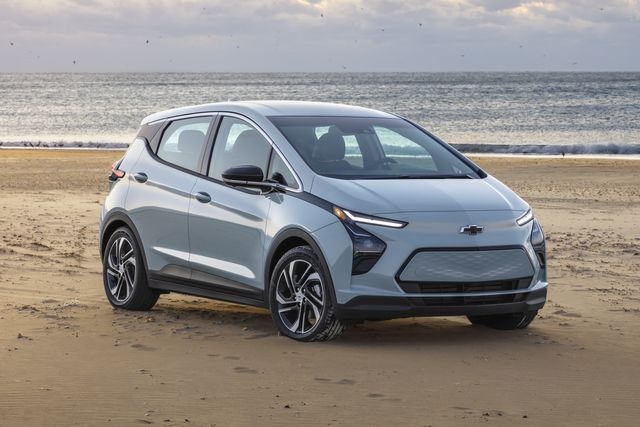 |
| Photo: Car And Driver |
Chevy has evolved the Bolt since it’s 2016 debut into an intriguing small electric hatchback with out-of-the-mainstream styling that offers a strong value proposition. The Bolt EV, not to be confused with the slightly larger Bolt EUV mini-SUV reviewed separately, is the least expensive EV sold in the U.S. today, making it a more accessible alternative to small EVs like the Tesla Model 3 and Hyundai Kona Electric. The Bolt is powered by a single 200-horsepower motor that powers its front wheels, a propulsion system that nets an EPA-estimated 259 miles on a single charge. The Bolt has DC fast-charge capability that Chevy says can add up to 100 miles of range in just 30 minutes. Inside is an unexpectedly roomy interior that previous Chevy drivers will find familiar; with its rear seatback folded the Bolt has nearly as much cargo space as a Chevy Equinox.
What's New for 2023?
The big change for the 2023 Chevy Bolt is a $5900 price drop versus the 2022 model—which brings its MSRP down by whopping $10,900 from the 2021 model for essentially the same car. This massive price cut Chevy is intended to keep the Bolt’s cost competitive now that the company has produced enough electric vehicles that it has lost the $7500 federal tax credit could be applied to its EVs. It’s also a balm to the Bolt’s reputation, which suffered a hit when the company issued a recall in the fourth quarter of 2020 for every Bolt the company had produced to fix a battery issue with the potential to cause a fire. Bolt EV and EUV production was ultimately suspended in November of 2021 until the issue was resolved. Production resumed in April of 2022. Other than the price revision, the only update is a new Radiant Red Tintcoat paint color.
Pricing and Which One to Buy
Bolt 1LT and 2LT trims get an EPA-estimated 259 miles of range and can accept DC fast charging. The 2LT trim adds heated leather seats, a heated steering wheel, a 360-degree camera and added driver safety features that make it worth the extra coin on this already highly-affordable electric hatchback.
EV Motor, Power, and Performance
Although we have not driven the 2023 Bolt EV, its powertrain and chassis are identical to older models that we have piloted. Its electric motor still sends 200 horsepower and 266 pound-feet of torque exclusively to the front wheels. This setup provides peppy response to accelerator inputs and ample low-end torque that lets you shoot off the line when the light turns green. Responses are less immediate at highway speeds, but the new electric Chevy should still make passing and merging on the highway a cinch. We anticipate that it will again deliver a composed ride and plenty of power—and a pleasant enough driving demeanor to challenge whatever negative preconceptions you might have about electric vehicles. There's also a one-pedal-driving mode—activated via a button on the center console—that increases regenerative braking to the point where you rarely need to use the brakes to slow down.
Fuel Economy and Real-World MPGe
The 2023 Bolt EV has a combined EPA rating of 120 MPGe. The last Bolt EV we evaluated achieved 102 MPGe in our real-world test, which translates to a highway range of 180 miles. You can expect to see significantly better range if you stick to lower speeds around town. In fact, during an unorthodox range test in California's Death Valley, we were able to exceed the EPA's 259-mile estimated driving range in the real world.
6. Vauxhall Corsa-e – $34,957
| Photo: Autocar |
The electric Corsa has enjoyed a bit of a head start in life; it shares oily bits (and electric bits) with the Peugeot e-208, in much the same way that petrol and diesel versions of the Corsa and 208 are alike. The main difference between them is, obviously, the styling.
Compared with the conventionally powered Corsa, the Corsa-e has a slightly longer wheelbase (the distance between a car’s front and rear wheels), with its rear axle pushed farther back to help accommodate the sizeable 50kWh battery that’s packaged in an H-shaped layout under the front and rear seats. The suspension and steering has also been tuned differently to cope with the substantial amount of weight added by the battery pack.
With a couple of trim level choices available, the Corsa-e joins what is a fast-growing small electric car market. Along with the e-208, it competes with cars like the Honda E, Mini Electric, Renault Zoe, and Seat Mii Electric among others.
While maximum electric range is a big buying motive for many, it’s not necessarily the only factor that determines an electric car’s appeal. So, does the Corsa-e strike a perfect mass-market electric car balance? Read on to find out, and to see how it compares with its rivals. And don’t forget, whatever car takes your fancy, our New Car Deals pages can make owning it easier than you think.
7. 2022 Chevrolet Bolt EUV - $33,500
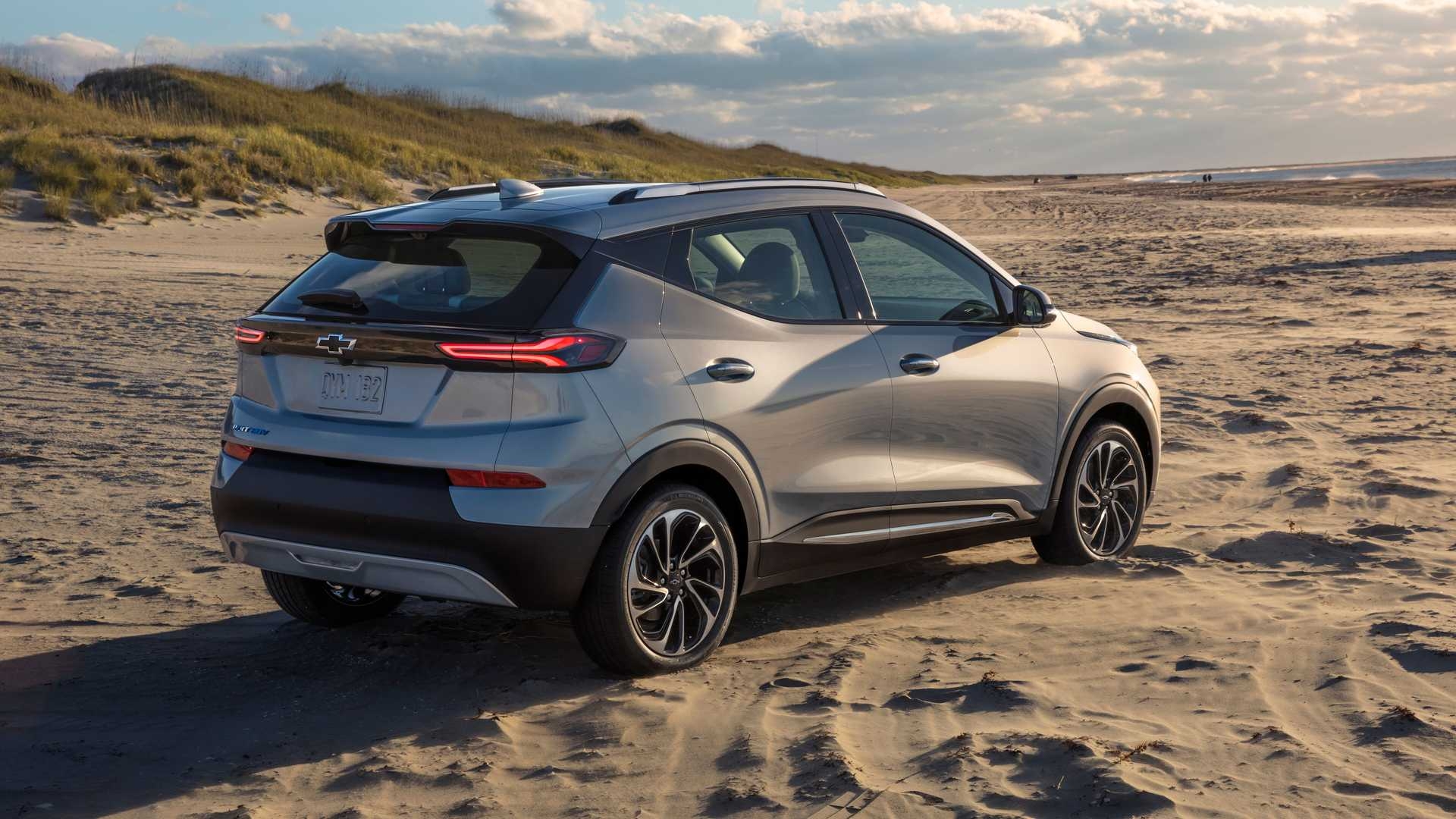 |
| Photo: InsideEVs |
The 2023 Chevrolet Bolt EUV takes the regular Bolt EV hatchback’s underpinnings and tops them with sheetmetal that makes it look much more like an SUV—which, of course, is the body style American buyers vastly prefer. Chevy squeezes 247 miles of driving range from the EUV’s 65.0-kWh battery pack. Not long ago that looked like an impressive amount of range; not anymore. The EUV’s 200-hp electric motor drives only the front wheels and provides decent performance, and there’s no pretense of any serious off-road capability—which puts the EUV on par with many of its rivals. After all, it’s not like EV SUVs such as the Hyundai Kona Electric, Ford Mustang Mach-E, and Tesla Model Y offer rock-crawling capabilities either. The Bolt EUV does have many competitors beat on tech in that the top-level Premier trim level can be had with General Motors’s Super Cruise hands-free driving feature. Recent price reductions have also given it an MSRP advantage over others in the segment, all of which cost more to start, though some are still eligible for a $7500 federal tax credit while the Chevy is not. In other words, whether the little Chevy is a good deal will depend on which other EVs are on your consideration list.
Pricing and Which One to Buy
We’d recommend the high-end Premier trim, especially now that the Bolt EUV’s price is significantly less than last year’s model. Going with the Premier adds plenty of standard equipment that justifies the extra spend, including leather upholstery, power-adjustable front seats with heat and ventilation, adaptive cruise control, lane-keeping assist, and blind-spot monitoring.
EV Motor, Power, and Performance
All Bolt EUVs come with the same powertrain: a 200-hp electric motor and front-wheel drive. All-wheel drive isn't an option. Acceleration should be perky thanks to the instantaneous power delivery that's inherent to electric motors. Regenerative braking allows for one-pedal driving while recapturing energy to help extend the Bolt EUV's range. The electric motor gives the Bolt EUV perky acceleration and while it may not be the quickest electric SUV available, it managed to 60 mph in a respectable 6.8 seconds at our test track. Handling is competent if not particularly thrilling and ride comfort is agreeable, even over broken pavement.
Range, Charging, and Battery Life
All Bolt EUVs come with a 65.0-kWh battery pack that the EPA estimates will provide 247 miles of range. During our 75-mph highway test, the 2022 Bolt EUV managed 190 miles of range. That number is competitive with most other electric SUVs, although the Tesla Model Y comes with a larger battery pack that offers an estimated 326-mile range. The Bolt EUV can be charged on a standard 120-volt household outlet, but buyers will want to consider a 240-volt connection for quicker at-home juice-ups. The SUV is also capable of DC fast charging, which Chevy says can provide up to 95 miles of range in just 30 minutes.
8. 2022 Mazda MX-30 - $33,470
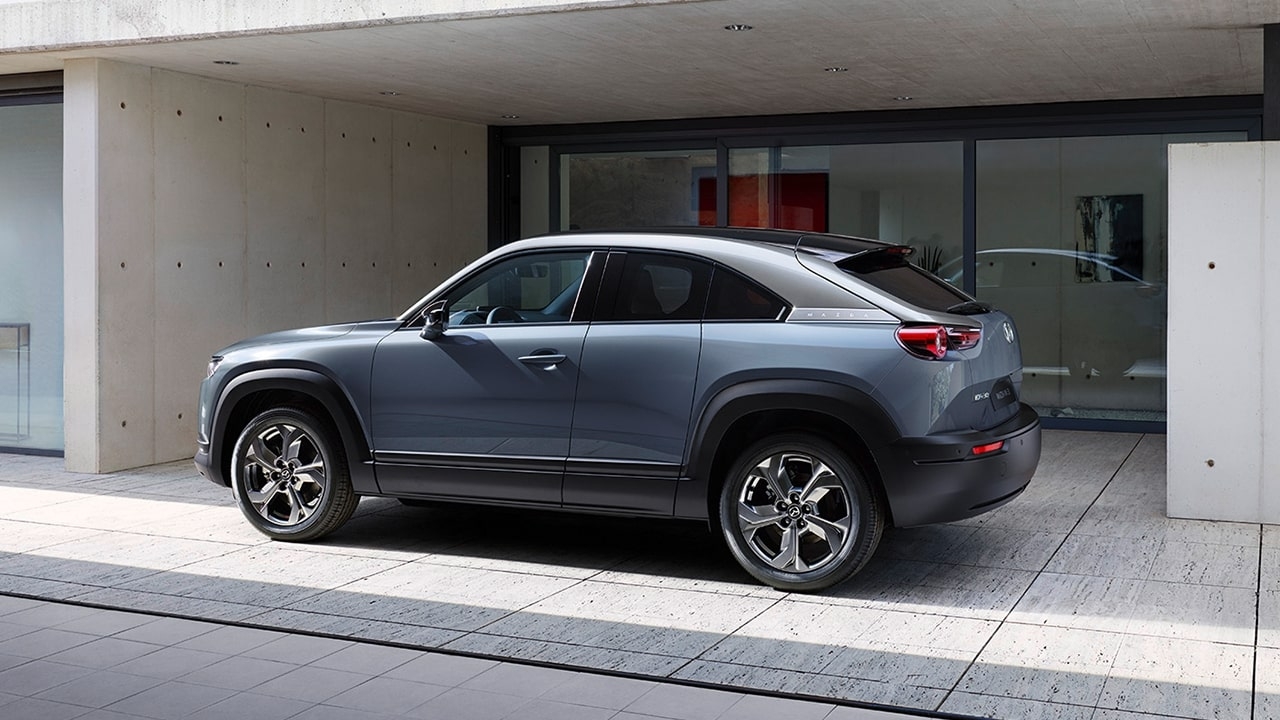 |
| Photo: Mazda |
Mazda's first all-electric vehicle is the MX-30 SUV, which sports a stylish exterior and simplistic cabin, but fails to deliver adequate driving range. The sharp exterior design provides a coupe-like roofline and rear-hinged back doors similar to those found on the BMW i3 electric car. The EV Mazda SUV comes with a 30.0-kWh battery pack that's good for up to 100 miles of driving range; a 143-hp electric motor drives the front wheels and acceleration isn't nearly as perky as rival EVs such as the Chevrolet Bolt, the Ford Mustang Mach-E, or the Tesla Model 3, all of which offer more than twice the driving range of the Mazda. At first, the MX-30 will be offered for sale only in California before expanding to other states.
Pricing and Which One to Buy
The MX-30 is offered in base and Premium Plus trims, but its prices are higher than mainstream rivals such as the Bolt and the Nissan Leaf. The Premium Plus model adds a lot of equipment, including active blind-spot assist, front cross-traffic alert, a 12-speaker Bose stereo system, a heated steering wheel, a 360-degree exterior camera system, and more.
EV Motor, Power, and Performance
The all-electric MX-30 comes with one 143-hp electric motor that drives the front wheels; all-wheel drive isn't available. However, we've also learned that there will be a plug-in-hybrid version that'll launch later and will pair an electric motor with a rotary gasoline engine, so perhaps all-wheel drive is still on the table. As its low horsepower rating suggests, the MX-30's acceleration isn't up to par with more powerful rivals and at our test track, it needed 8.7 seconds to reach 60 mph. The chassis is playful and steering is sharp, which is what we expect from a modern Mazda. That eager handling is what earns this SUV the MX in its name, a prefix which is shared only with the brand's MX-5 Miata sports car.
Range, Charging, and Battery Life
Compared to other electric vehicles, the MX-30's 30.0-kWh battery pack is small. The EPA estimates its driving range will only be around 100 miles per charge, which is less than half that of the Bolt and the Kona Electric. The battery will be capable of charging on standard AC power as well as more modern and faster DC chargers.
9. 2022 Hyundai Kona Electric - $34,000
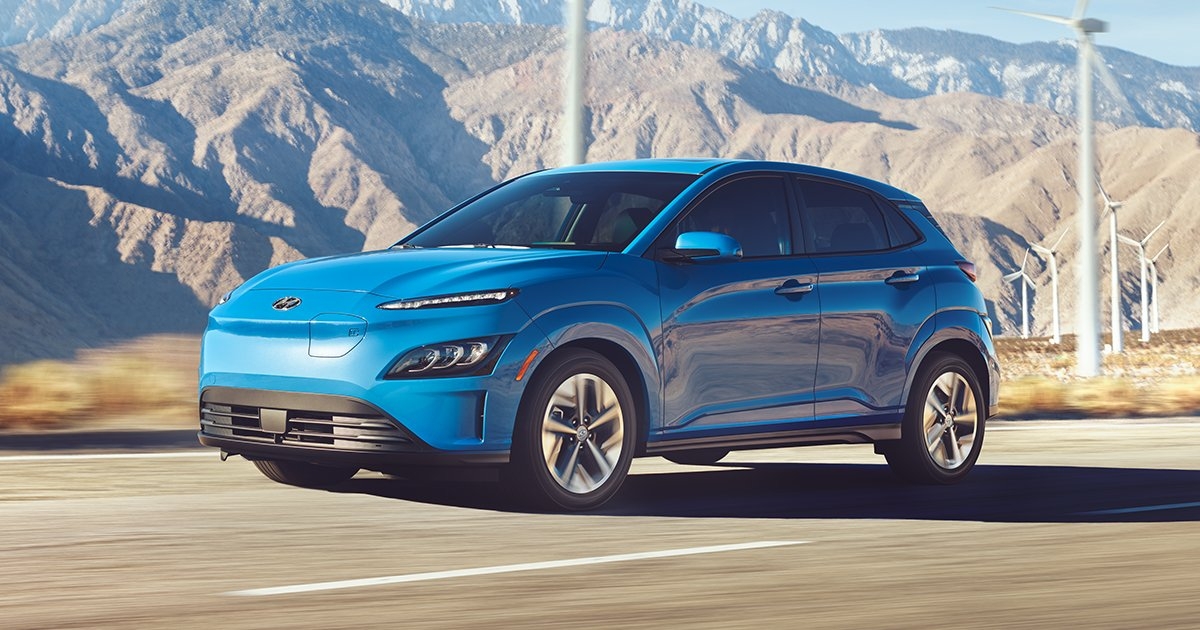 |
| Photo: Huyndai |
Turns out that the subcompact Hyundai Kona SUV is a fine basis for an electric vehicle, as the 2022 Kona Electric retains everything we like about its gas-powered counterpart. Instead of a four-cylinder engine, the Kona Electric is powered by a 201-hp electric motor, and its large battery pack is good for up to 258 miles per charge. That's key because an EV's range number is the most important factor in the revved-up electric vehicle marketplace. Chevrolet's new Bolt EUV carries a claimed 250-mile range while the Tesla Model Y is good for up to 326 miles per charge. On top of its competitive estimated driving range, the Kona Electric delivers perky acceleration, spry handling, and an unbeatable standard warranty and complimentary maintenance package, making it worthy of an Editors' Choice award.
Pricing and Which One to Buy
We'd recommend the SEL trim with the optional Convenience package. Although the SEL comes fairly well equipped right out of the gate, the Convenience package adds several desirable features, including a sunroof, a wireless smartphone-charging pad, and heated front seats.
EV Motor, Power, and Performance
A 201-hp electric motor drives the front wheels (all-wheel drive isn't offered) and is powered by a 64.0-kWh battery pack. At our test track, the Kona Electric galloped from zero to 60 mph in 6.4 seconds, 0.2 second quicker than the regular Kona. As with the regular Kona, the electric version offers sprightly driving dynamics, which makes it fun to scamper along a twisty two-lane. It doesn't offer sports-car-level thrills, but for a subcompact SUV it's compelling to drive. It also cruises smoothly at highway speeds and feels substantial and planted thanks to the heavy battery mounted in the floor and its resulting low center of gravity.
Range, Charging, and Battery Life
Aggressive regenerative braking allows for true one-pedal driving and helps extend the driving range to a claimed 258 miles—one mile less than the Bolt EV. Pulling the paddles behind the steering wheel allows the driver to adjust the level of regen; we prefer the most aggressive setting. The Kona Electric can be charged on a 110-volt household outlet, but we wouldn't recommend that on a day-to-day basis; a 240-volt outlet is best for home charging, and the Kona Electric also can be charged at a DC fast-charging station.
10. 2022 Mini Electric - $34,225
 |
| Photo: AutoTrader |
Just like the original Mini changed the way people thought about small cars back in the ‘60s, the Mini Electric could change the way you think about electric cars today.
In size and shape it’s the same as any other three-door Mini hatchback, plus it has the look and badging of the sporty Cooper S model, but its 32kWh battery and electric motor help it travel up to 145 miles between charges. That’s a little further than a Honda e, but short of the cheaper Peugeot e-208 or Renault Zoe.
If you are not sure about EVs, Mini has tried to keep its design as ‘normal’ as possible. Sure, you can have eye-catching three-pin-plug style wheels and fluorescent accents if you wish, but if you don’t want to stand out, then you can have all the usual Mini wheels and paints instead.
Aside from a fluro starter button and drive selector, the only major giveaway that this Mini is a bit different inside are some fantastic new digital dials. They’re almost oval in shape and have a classy matte finish, displaying your range, power use and speed and trip info clearly.
Otherwise, you get the same funky design with Mini’s trademark circular centrepiece on the dash, plus a very good fit and finish. You’ll also find Mini’s usual infotainment system, that includes sat-nav with charging station info and Apple CarPlay and is controlled via touch or a rotary dial and menu shortcut buttons between the front seats.
Space is unchanged, too, so although two adults will be able to stretch out in comfort upfront, another two adults in the back will feel pretty cramped. Its boot is also the same: a pretty average 211 litres, some of which accommodates the Electric’s charging cables.
You can charge the Mini Electric’s battery from empty to full at home using a 7kW wall box charger in a little under five hours. However, find a 50kW rapid charger out on the street and a top-up from 10-80% will take just 28 minutes. That full home charge will cost you around £5, which is around £16 cheaper than fueling the average petrol car over the same range.
And if you were worried about the Electric’s performance, you needn’t – it’ll crack 0-62mph in just 7.3 seconds, which is nearly as quick as the turbocharged petrol Cooper S. In town, this translates to nippy darting in and out of traffic, while out on country roads the Electric feels outright fast, and fun, thanks to its good grip and quick, precise steering.
Spoiling things a little is the fact that the Electric feels firm over lumps and bumps, although this does get better once you’re on the motorway, where road and wind noise are also kept to a minimum.
So, there are comfier EVs for similar money, and more practical options too, but if you can put up with both and love the MINI’s look, you’ll love the Mini Electric.
 Top 10 Cheapest Places To Buy Petrol And Diesel In Canada Top 10 Cheapest Places To Buy Petrol And Diesel In Canada Let's check top 10 cheapest places to buy petrol and gas in Canada. |
 Top 10 Cheapest Gas Stations In New Jersey That You Keep in Mind Top 10 Cheapest Gas Stations In New Jersey That You Keep in Mind With New Jersey being one of the states with the highest gas prices in the United States, these are the 10 cheapest gas stations you ... |
 Top 10 Cheapest Gas Stations In New York That You Keep in Mind Top 10 Cheapest Gas Stations In New York That You Keep in Mind With New York being one of the states that have the highest gas prices ever, these cheapest gas stations will help you save some pennies. |
 Top 10 Cheapest Gas Stations In Texas That You Keep in Mind Top 10 Cheapest Gas Stations In Texas That You Keep in Mind Take a look at the article below for the cheapest gas stations in Texas and more information on the gas prices in this state. |


























